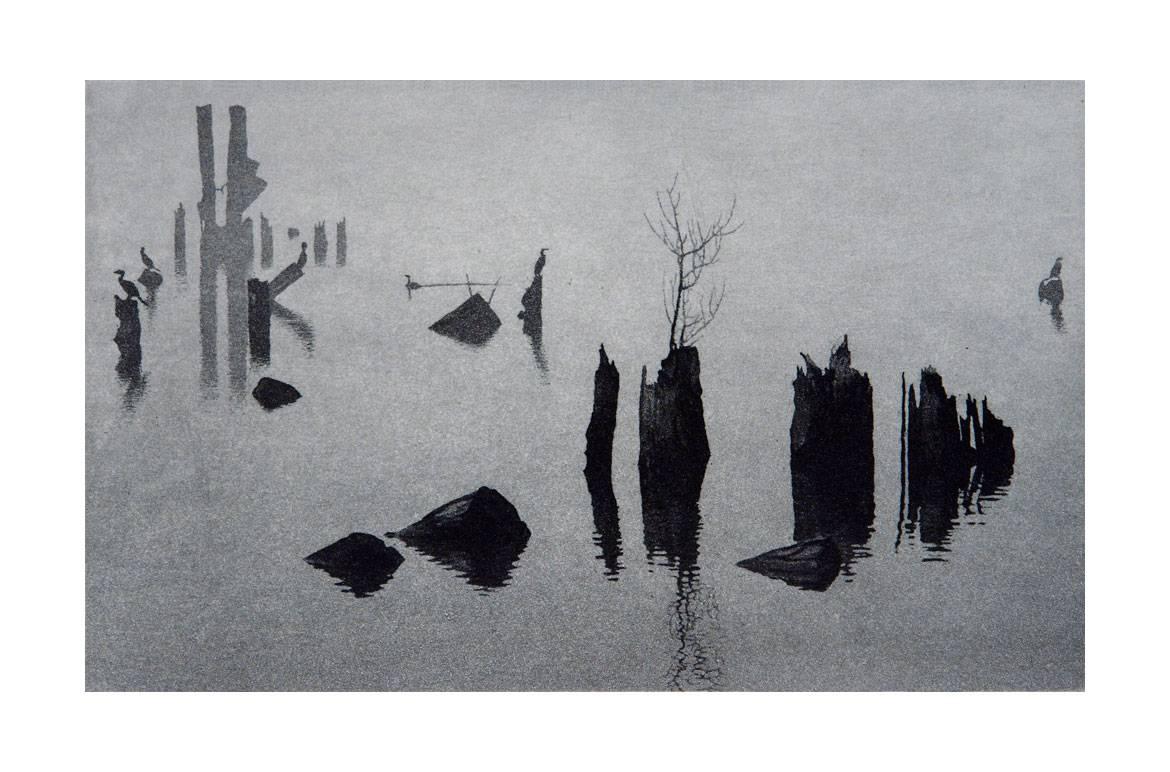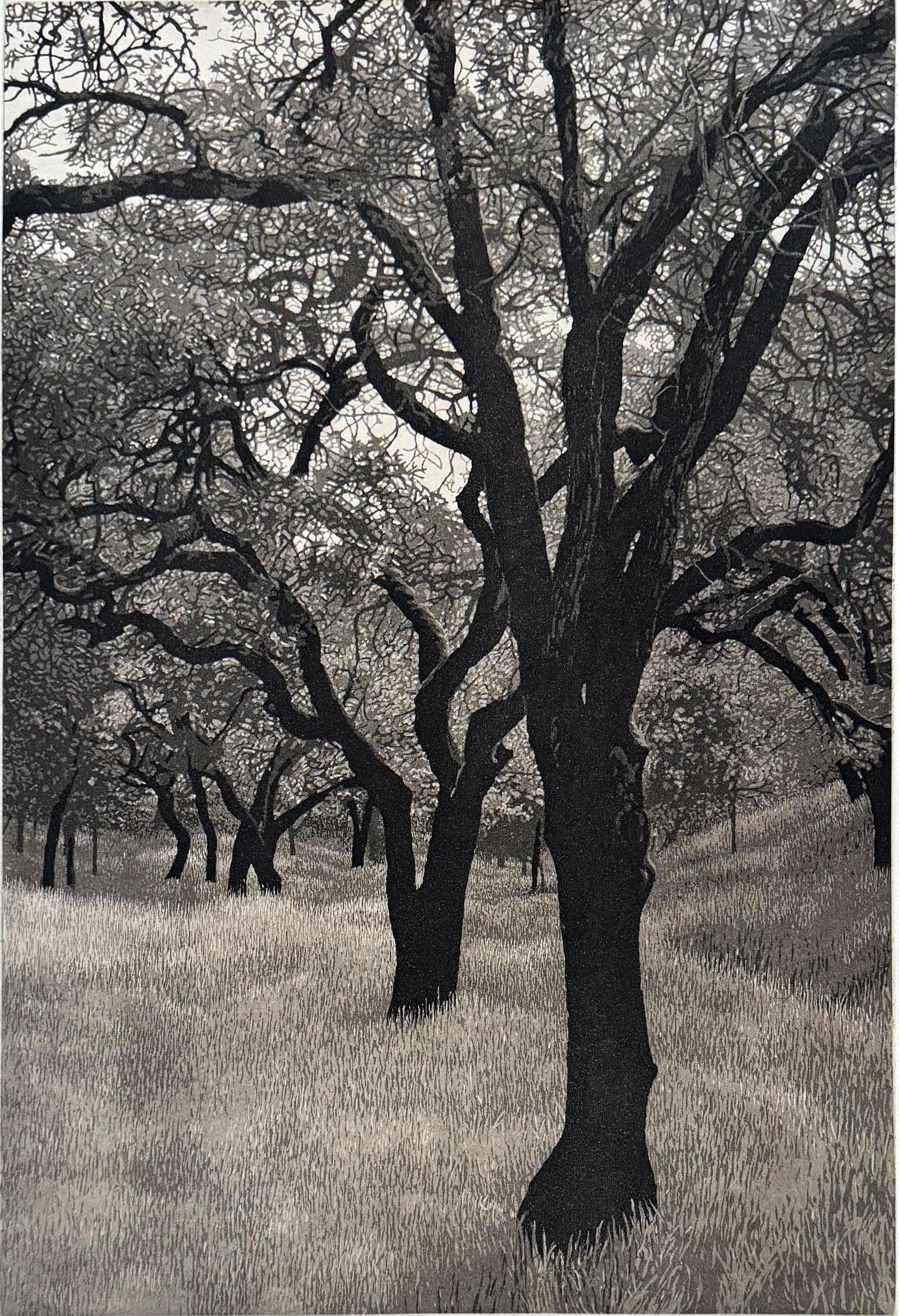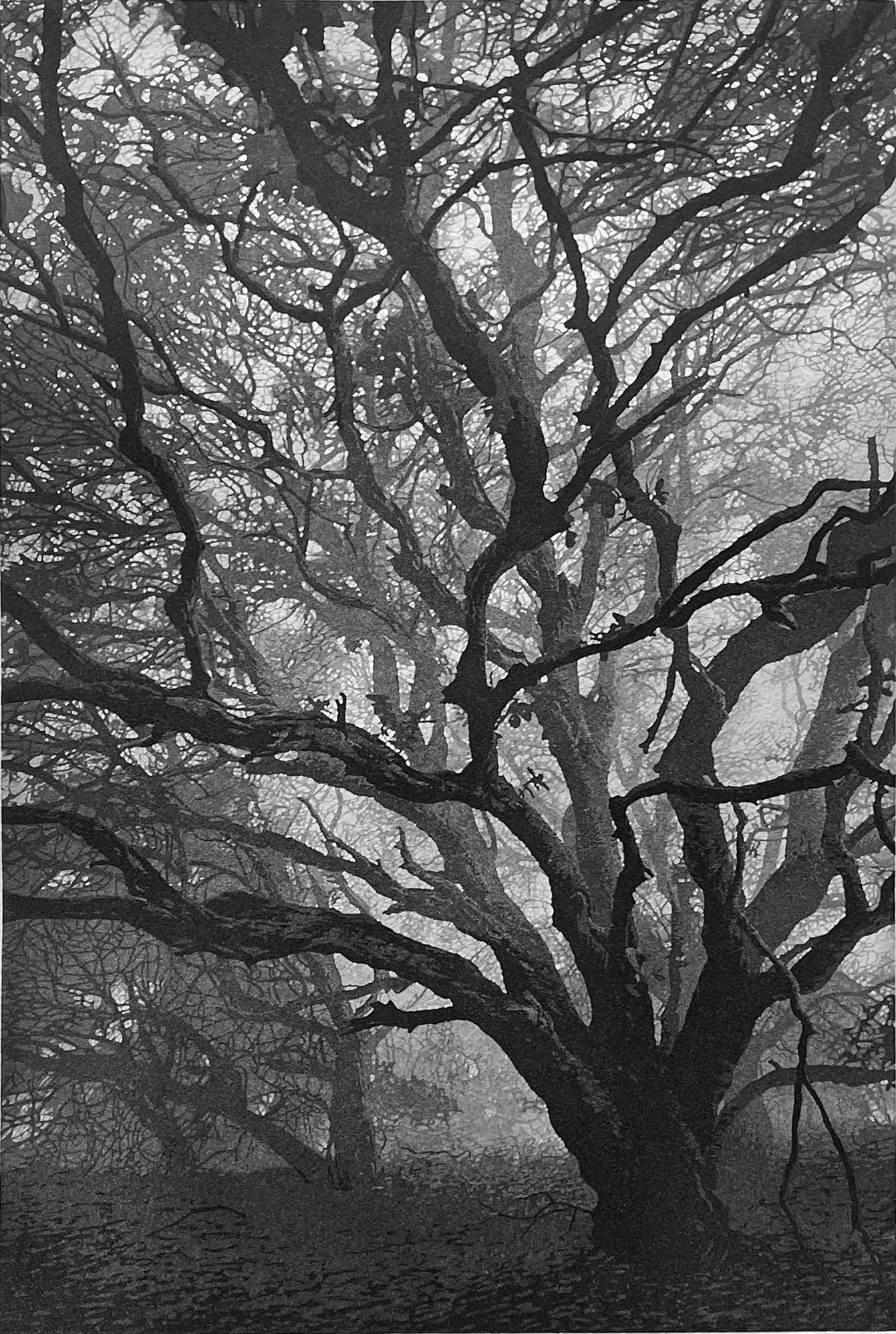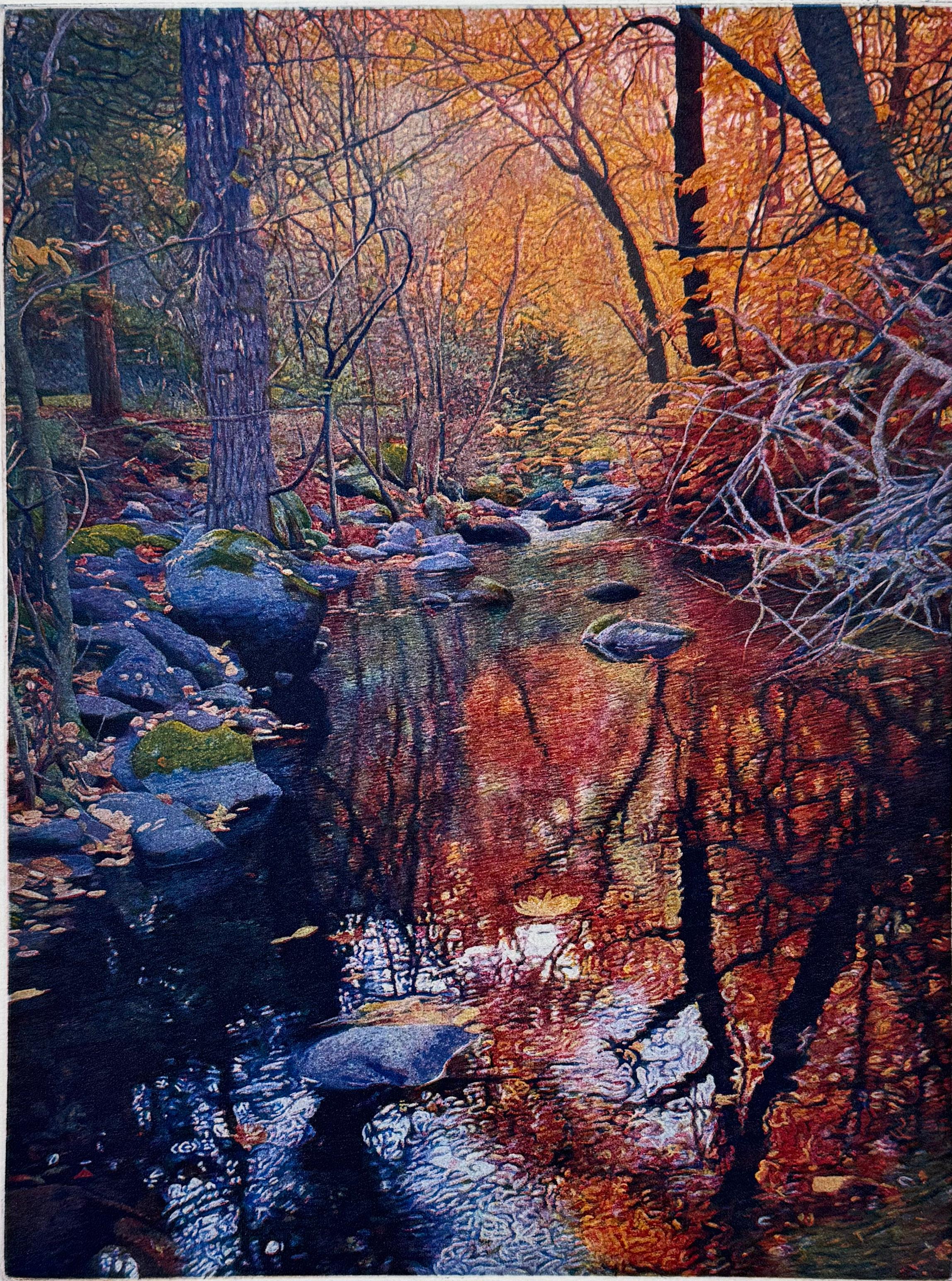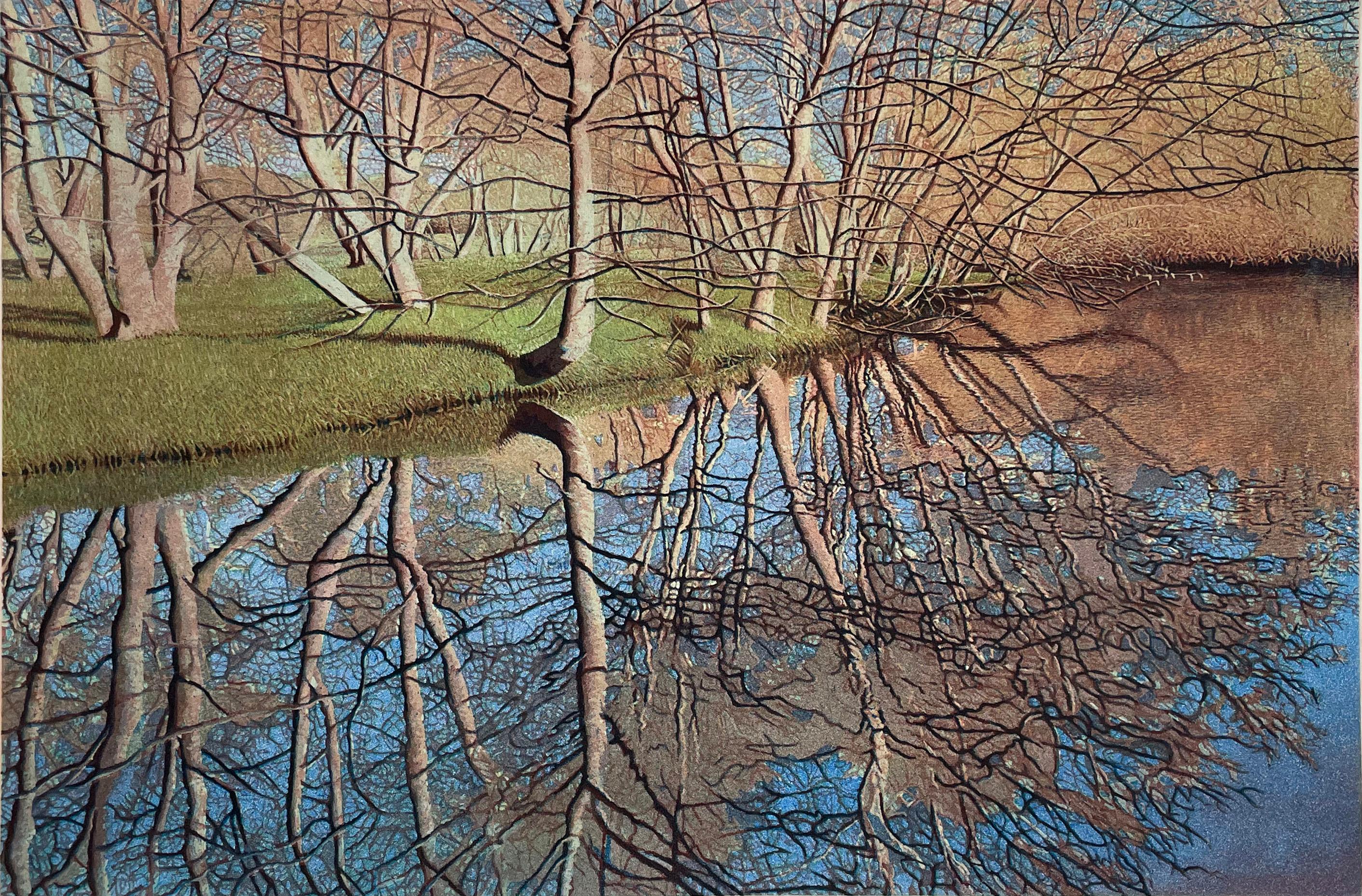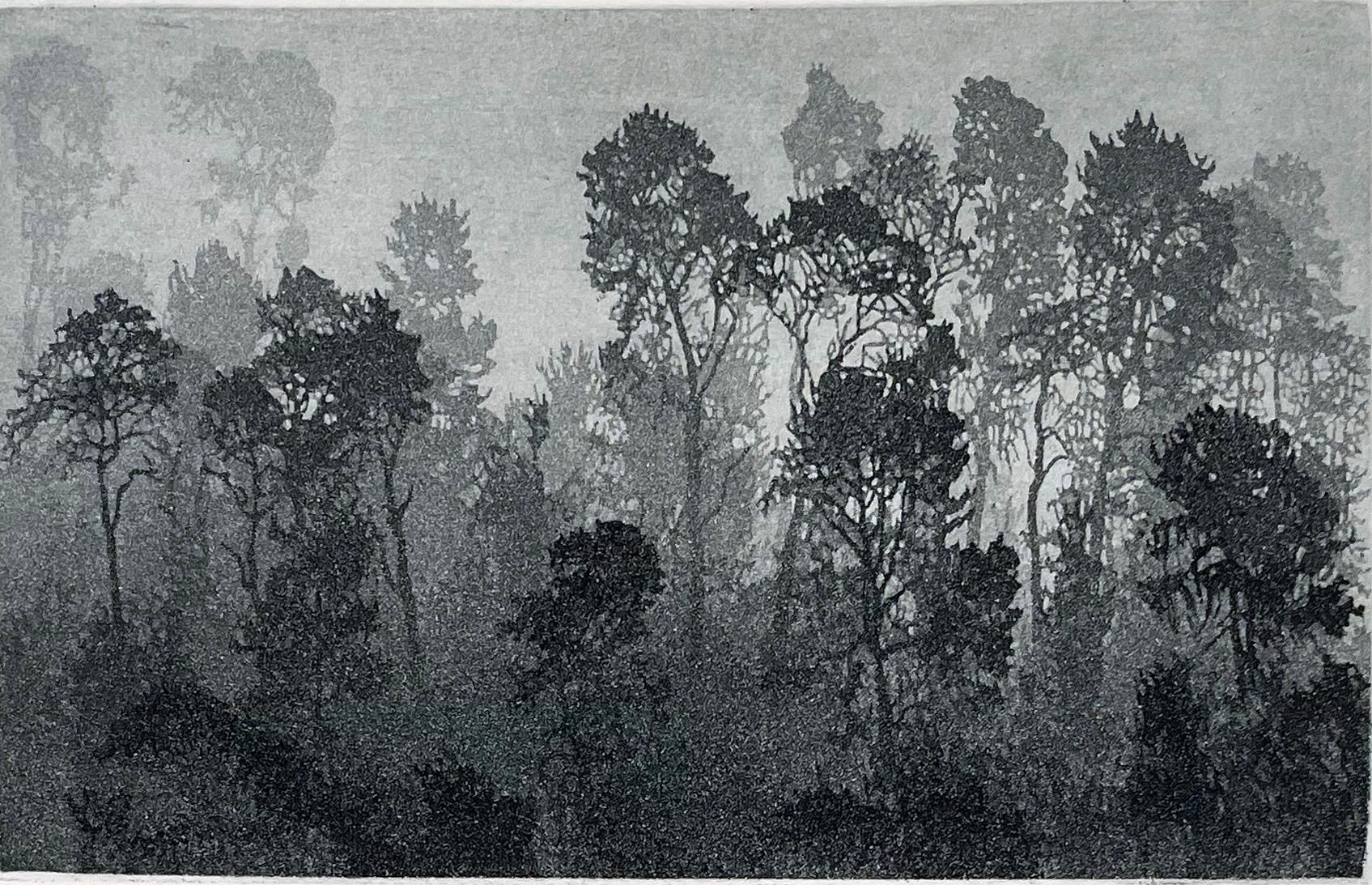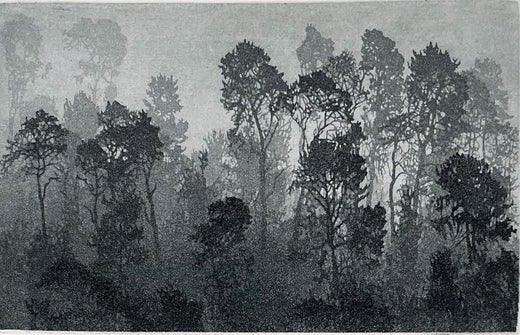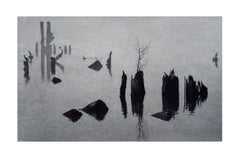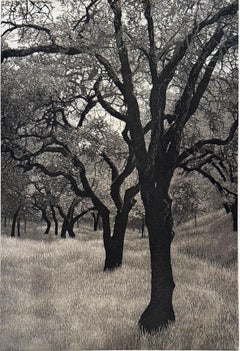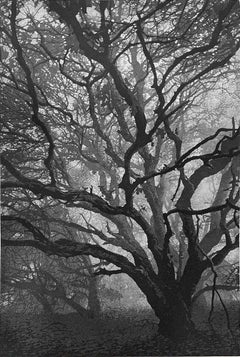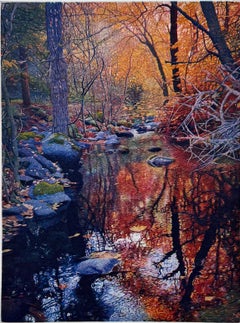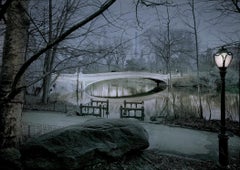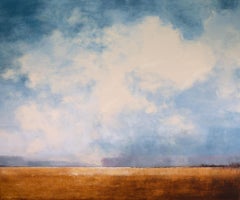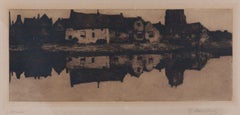Items Similar to Morning Meditation, by Stephen McMillan
Want more images or videos?
Request additional images or videos from the seller
1 of 8
Stephen McMillanMorning Meditation, by Stephen McMillan2020
2020
$300
£227.86
€263.25
CA$420.46
A$470.57
CHF 245.60
MX$5,738.59
NOK 3,143.40
SEK 2,975.63
DKK 1,964.60
Shipping
Retrieving quote...The 1stDibs Promise:
Authenticity Guarantee,
Money-Back Guarantee,
24-Hour Cancellation
About the Item
Signed, titled and numbered aquatint print, Printed on Arches Cover Paper. A gentle fog descending on Lake Whatcon on a December morning. A walking meditation.
This is a great example of McMillan's work. He takes his inspiration from the natural world and spends a large part of each year backpacking and hiking through the mountains, beaches and deserts that make up the Northwest United States and California where he has lived his entire life. His aquatints are often relate directly to photos he takes on these trips.
Born in Berkeley, California, on December 21, 1949, he was raised in a home that had a sweeping view of the San Francisco Bay. This scene kindled his interest in landscape and was one of his earliest drawing subjects. Stephen McMillans etchings and aquatint prints capture the landscapes of California and Washington, and continue to be his primary inspiration.
McMillan received a BFA from University of California, Santa Cruz, and studied sculpture for one year at Hornsey College of Art in London. In 1969, he was introduced to etching. He has since focused on creating aquatint etchings of wilderness landscapes drawn freehand from the photographs he takes.
- Creator:Stephen McMillan (1949, American)
- Creation Year:2020
- Dimensions:Height: 12 in (30.48 cm)Width: 18 in (45.72 cm)
- Medium:
- Movement & Style:
- Period:
- Condition:
- Gallery Location:Palm Springs, CA
- Reference Number:1stDibs: LU30828336252
Stephen McMillan
Born in Berkeley, California, on December 21, 1949, Stephen was raised in a home that had a sweeping view of the San Francisco Bay. This scene kindled his interest in landscape and was one of his earliest drawing subjects. He had his first one man show when he was sixteen. Throughout his life, Steve McMillan has been inspired and sustained by the natural world and has spent much of his time outside. Whether it's a bike ride in the Sonoma countryside, or a week-long backpacking trip in the High Sierra, he is renewed and invigorated by being in and moving through landscape. It is this sense of renewal that he seeks to share with others. Stephen studied art at the University of California, Santa Cruz, and also one year at Hornsey College of Art in London, England, where he concentrated on sculpture. It was at Santa Cruz, in 1969, that Steve was first introduced to etching. Since receiving his BFA from UCSC in 1975, he has focused on creating aquatint etchings of landscapes, drawn freehand from photographs he takes. From 1975 to 1979 he worked at Graphic Arts Workshop in San Francisco. For most of the years from 1979 to 1992 he was an artist in residence at Kala Art Institute in Berkeley, where he taught classes in printmaking, and wrote three technical articles about aquatint etching. In 1992 he moved to Petaluma, California, and set up a printmaking studio in his home. In 2006 he moved north to set up a new studio in Bellingham, Washington.
About the Seller
4.9
Recognized Seller
These prestigious sellers are industry leaders and represent the highest echelon for item quality and design.
Gold Seller
Premium sellers maintaining a 4.3+ rating and 24-hour response times
Established in 1998
1stDibs seller since 2015
530 sales on 1stDibs
Typical response time: 1 hour
- ShippingRetrieving quote...Shipping from: Palm Springs, CA
- Return Policy
Authenticity Guarantee
In the unlikely event there’s an issue with an item’s authenticity, contact us within 1 year for a full refund. DetailsMoney-Back Guarantee
If your item is not as described, is damaged in transit, or does not arrive, contact us within 7 days for a full refund. Details24-Hour Cancellation
You have a 24-hour grace period in which to reconsider your purchase, with no questions asked.Vetted Professional Sellers
Our world-class sellers must adhere to strict standards for service and quality, maintaining the integrity of our listings.Price-Match Guarantee
If you find that a seller listed the same item for a lower price elsewhere, we’ll match it.Trusted Global Delivery
Our best-in-class carrier network provides specialized shipping options worldwide, including custom delivery.More From This Seller
View AllGathering
By Stephen McMillan
Located in Palm Springs, CA
A gathering of of birds and ducks on a foggy morning make for a meditative water scene from the artist's northwestern landscapes. Signed, titled and numbered (AP III/XXV).
Born in B...
Category
2010s Contemporary Landscape Prints
Materials
Etching, Aquatint
Summer Afternoon, by Stephen McMillan
By Stephen McMillan
Located in Palm Springs, CA
Signed, titled and numbered aquatint print. Summer light infuses the Live Oaks in a park near the town of Sonoma, CA. Wheat colored grasses rustle lightly in the brease.
This is a g...
Category
2010s Contemporary Landscape Prints
Materials
Etching, Aquatint
Winter Morning
By Stephen McMillan
Located in Palm Springs, CA
Signed, titled and numbered aquatint print. In the Fall and Winter cool damp fogs often descend upon the hills around Petaluma. This can be a magical time to wander through the nativ...
Category
2010s Contemporary Landscape Prints
Materials
Etching, Aquatint
Autumn Light, by Stephen McMillan
By Stephen McMillan
Located in Palm Springs, CA
Signed, titled and numbered by the artist.
Medium: etching and aquatint
Image size: 12 x 9 inches
Year: 2019
Fall colors along Ashland Creek in Lithia Park.
Born in Berkeley, Ca...
Category
Early 2000s Contemporary Landscape Prints
Materials
Etching, Aquatint
Creekside, by Stephen McMillan
By Stephen McMillan
Located in Palm Springs, CA
Signed, titled and numbered from the edition of 120. Alder trees reflect in the waters of Bear Creek in Ashland, Oregon. The first green of spring graces the shore.
Born in Berkeley, California, on December 21, 1949, he was raised in a home that had a sweeping view of the San Francisco Bay. This scene kindled his interest in landscape and was one of his earliest drawing subjects. Stephen McMillans etchings and aquatint prints capture the landscapes of California...
Category
2010s Contemporary Landscape Prints
Materials
Etching, Aquatint
Coastal Fog
By Stephen McMillan
Located in Palm Springs, CA
Trees in fog. A band of fog off of the Pacific, pouring its way through the forest in Fiscalini Ranch, Cambria.
Born in Berkeley, California, on December 21, 1949, he was raised in ...
Category
2010s Contemporary Landscape Prints
Materials
Etching, Aquatint
You May Also Like
Michael Massaia - Ramble Sunrise, Photography 2024, Printed After
By Michael Massaia
Located in Greenwich, CT
Series: Deep In A Dream-Central Park
Print Type: Selenium, Sepia, & Iron Toned Gelatin Silver
Printed on Bergger Prestige Fiber Based Paper
Matted & Mounted 8ply Museum Board
Avai...
Category
2010s Landscape Prints
Materials
Paper, Board, Silver Gelatin
"Morning Stillness"
Located in Zofingen, AG
"Morning Stillness" is my exploration of the quiet, meditative beauty of dawn. I wanted to capture the way the sky gently awakens, blending soft blues and warm golds as light emerges...
Category
2010s Landscape Paintings
Materials
Acrylic
Morning Tranquility 2
By Ann Shogren
Located in Napa, CA
Abstract expressionist Ann Shogren depicts vivid landscapes and paints tapestries of colors that have simultaneously calming and rejuvenating effects on her audiences. Having lived in Iowa, Utah, and the California Wine Country, Shogren draws inspiration from the landscapes that surround her, creating energetic, colorful compositions that seem to have their own life upon the canvas. Shogren lives and works in Paso Robles...
Category
21st Century and Contemporary Abstract Expressionist Landscape Paintings
Materials
Canvas, Oil
Evening - The depth of the visible -
Located in Berlin, DE
Max Clarenbach (1880 Neuss - Cologne 1952), Evening. Etching, 18 x 41 cm (platemark), 33.5 x 57 cm (frame), inscribed "Abend" in pencil at lower left, signed and dated "M. Clarenbach. 28.III.[19]09". Framed and mounted under glass.
- Somewhat browned and slightly foxed.
About the artwork
The horizontally elongated etching depicts the panoramic view of a small town as seen from the other side of the river. There are gabled houses on the left and a mighty church spire on the right. The bourgeois houses and the large religious building indicate the urban character. These buildings are rendered in dark tones to emphasise the lighter row of houses in the centre of the picture, closer to the water. The chiaroscuro contrast creates two parallel planes that open up a space for the imagination of what the city could be. The imagination is stimulated by the almost entirely dark, barely recognisable buildings, while the arm of the river leading into the city further stimulates the imagination.
However, as the silhouette of the city as a whole is reflected in the water, the parallel planes are perceived as a band of houses that stretches across the entire horizontality of the etching and seems to continue beyond the borders of the picture. The reflection has almost the same intensity as the houses themselves, so that the band of buildings merges with their reflection to form the dominant formal unit of the picture. Only the parallel horizontal hatching creates the convincing impression of seeing water, demonstrating Max Clarenbach's mastery of the etching needle.
The water is completely motionless, the reflection unclouded by the slightest movement of the waves, creating a symmetry within the formal unity of the cityscape and its reflection that goes beyond the motif of a mere cityscape. A pictorial order is established that integrates everything in the picture and has a metaphysical character as a structure of order that transcends the individual things. This pictorial order is not only relevant in the pictorial world, but the picture itself reveals the order of the reality it depicts. Revealing the metaphysical order of reality in the structures of its visibility is what drives Clarenbach as an artist and motivates him to return to the same circle of motifs.
The symmetry described is at the same time inherent an asymmetry that is a reflection on art: While the real cityscape is cut off at the top of the picture, two chimneys and above all the church tower are not visible, the reflection illustrates reality in its entirety. The reflection occupies a much larger space in the picture than reality itself. Since antiquity, art has been understood primarily as a reflection of reality, but here Clarenbach makes it clear that art is not a mere appearance, which can at best be a reflection of reality, but that art has the potential to reveal reality itself.
The revealed structure of order is by no means purely formalistic; it appears at the same time as the mood of the landscape. The picture is filled with an almost sacred silence. Nothing in the picture evokes a sound, and there is complete stillness. There are no people in Clarenbach's landscape paintings to bring action into the picture. Not even we ourselves are assigned a viewing position in the picture, so that we do not become thematic subjects of action. Clarenbach also refrains from depicting technical achievements. The absence of man and technology creates an atmosphere of timelessness. Even if the specific date proves that Clarenbach is depicting something that happened before his eyes, without the date we would not be able to say which decade, or even which century, we are in. The motionless stillness, then, does not result in time being frozen in the picture, but rather in a timeless eternity that is nevertheless, as the title "Abend" (evening), added by Clarenbach himself, makes clear, a phenomenon of transition. The landscape of the stalls is about to be completely plunged into darkness, the buildings behind it only faintly discernible. The slightly darkened state of the sheet is in keeping with this transitional quality, which also lends the scene a sepia quality that underlines its timelessness. And yet the depiction is tied to a very specific time. Clarenbach dates the picture to the evening of 28 March 1909, which does not refer to the making of the etching, but to the capture of the landscape's essence in the landscape itself.
If the real landscape is thus in a state of transition, and therefore something ephemeral, art reveals its true nature in that reality, subject to the flow of phenomena, is transferred to an eternal moment, subject to a supra-temporal structure of order - revealed by art. Despite this supratemporality, the picture also shows the harbingers of night as the coming darkening of the world, which gives the picture a deeply melancholy quality, enhanced by the browning of the leaf.
It is the philosophical content and the lyrical-melancholic effect of the graphic that give it its enchanting power. Once we are immersed in the image, it literally takes a jerk to disengage from it.
This etching, so characteristic of Max Clarenbach's art, is - not least because of its dimensions - a major work in his graphic oeuvre.
About the artist
Born into poverty and orphaned at an early age, the artistically gifted young Max Clarenbach was discovered by Andreas Achenbach and admitted to the Düsseldorf Art Academy at the age of 13.
"Completely penniless, I worked for an uncle in a cardboard factory in the evenings to pay for my studies.”
- Max Clarenbach
At the academy he studied under Arthur Kampf, among others, and in 1897 was accepted into Eugen Dücker...
Category
Early 1900s Realist Landscape Prints
Materials
Etching
$550 Sale Price
20% Off
Morning Breaking
By Michael Massaia
Located in New York, NY
Archival pigment print with 8-ply over-mat and mounted to archival, 4-ply Crescent Natural White mat board
Signed and numbered, recto
30 x 26 inches, overall mat size
24 x 20 inche...
Category
2010s Contemporary Landscape Photography
Materials
Archival Pigment
Price Upon Request
Morning
By Alicia Rothman
Located in New York, NY
oil and ink on wood
Category
2010s Contemporary Landscape Paintings
Materials
Ink, Oil, Panel
More Ways To Browse
C S Lewis
Pieta Sculpture
Yayoi Kusama Original
19th Century French Religious Oil Painting
Chinese Ceramic Children
Danish Girl Painting
De Gaulle
Girl With A Pearl Earring
Nicholas Stone
Vintage Baby Dior
Vintage Coney Island Signs
50s Vintage Hats
Avigdor Bezalel
Balloon Girl
Bearbrick 400
Maillol Bronze
Morris William Glass
Player Piano
